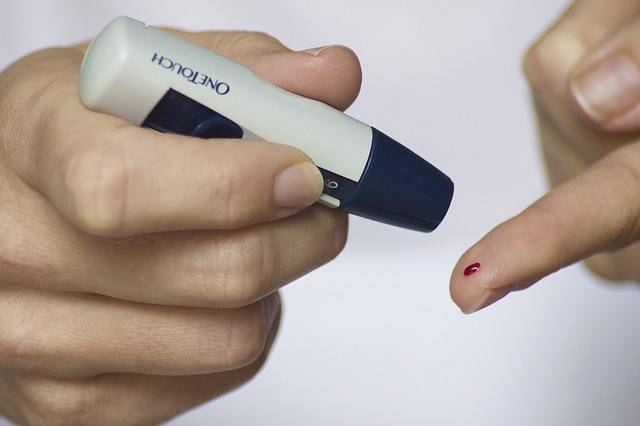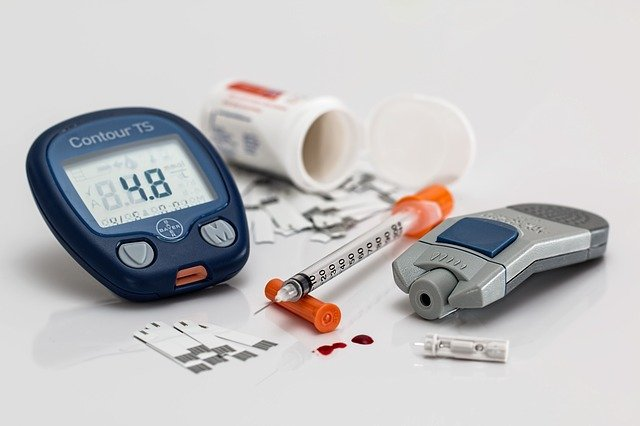Do I have Diabetes? Causes and Symptoms and Treatments


Diabetes mellitus is a disease caused by either decreased secretion of insulin hormone or resistance to insulin in the body resulting in a higher than normal level of glucose in the blood. There are two types of diabetes mellitus; type 1 and type. Type 1 is most commonly found in children and young adults while type 2 predominantly occurs in adults. Two hours after eating, the normal blood glucose reaches 140mg/dl, documented higher than this number on more than one occasion is not a good sign for your health. The underlying causes which lead to diabetes are Immune-mediated, obesity, lack of exercise, high glucose intake, etc... Noticing some alarming changes in your body or your loved one like increased thirst, weakness, feeling tired, dry mouth, more than normal urination, slow-healing of infections, etc... are the main symptoms that suspicious you of having diabetes mellitus.
According to American Diabetes Association (ADA), it is believed that an estimated 9% of the world population has diabetes mellitus and this number is increasing day by day.
In this article, we are trying to deliver you a deep and comprehensive understanding of diabetes mellitus its causes, and alarming signs and symptoms. That will help you to keep aware of this life-threatening condition.

There are two main types of diabetes mellitus
Type 1 diabetes is characterised by the absence of insulin production by the body. Your immune system tries to kill the cells in your pancreas that make insulin. Type 1 diabetes is diagnosed most frequently in children and adolescents, but it can manifest at any age. Those who have this type of diabetes must have a daily insulin dose.
Your body produces and utilises insulin inefficiently. Type 2 diabetes can occur at any age, including youth. However, this type of diabetes is more prevalent among middle-aged and elderly individuals. Type 2 diabetes is the most prevalent type.
Gestational diabetes: Gestational diabetes occurs in certain pregnant women. Generally, this kind of diabetes resolves once the baby is born. In the event that you have this type of diabetes, your risk of acquiring type 2 diabetes in later years increases.
This type of diabetes is due destruction of pancreatic B cells by an autoimmune reaction Pancreatic B cells are principles cells of the pancreas which secret Insulin hormones to the blood to control the level of glucose in the body. It occurs at any age of life but most commonly arises in childhood and young adulthood. It is a catabolic type where the pancreatic B cells became unable to release Insulin resulting in the absence of circulating insulin and the blood glucose becoming elevated. Therefore exogenous insulin is required to control the plasma glucose level and prevent ketosis.
A child who has a family history of diabetes mellitus is at high risk of developing type 1 diabetes mellitus. There is a 3% risk of diabetes in a child whose mother has type1 and a 6% risk whose father has type1 diabetes.
Although 95% of cases of Type1 are genetic, some environmental factors are responsible for the increased risk. Different hypotheses describe that some viral infections like mumps, rubella Coxsackie and Cow's milk are included in these factors.
Some typical clinical signs and symptoms are found in individual who has type1 diabetes.
1. Most common symptom in a patient who has type1 diabetes is weight loss despite normal appetite. Muscle mass is reduced due to the depletion of glycogen.
2. A complex of hyperosmolarity and hyperketonemia from the accumulation of circulating glucose and fats is found in the plasma of Type1 diabetes.
3. Increased urination, thirst, and blurred vision are common clinical findings in the patient.
4. When the onset is acute, it causes temporary dysfunction of sensory nerve symptoms, which leads to paresthesias of the body.
5. The plasma volume is lost due to the loss of potassium from muscle protein, resulting in weakness and hypotension.
In type2 diabetes mellitus, there is a sufficient amount of insulin is present in the plasma but it is inadequate to control the blood glucose due to the insensitivity of insulin to the target tissues, resulting in hyperglycemia of the blood. Some genetic and environmental factors are involved to make the target tissue insulin resistant and insensitive. At the early stage of the disease, hyperplasia of the pancreatic B cells occurs, later on, chronic deposition of Amyloid impaired the function of B cells. Predominantly this type occurs in adults but cases also have been reported in young individuals.
Obesity is the most important risk factor causing insulin resistance. According to research, 60-70% of type 2 diabetes mellitus is found in the obese American population. Increase fats in the body deposit in the insulin target tissue which make that tissue insensitive to insulin. Other factors including lack of exercise, high glucose intake, etc... also contribute to type2 diabetes.
What are the common symptoms of type 2 diabetes mellitus?
Initially, the patient with type2 diabetes is asymptomatic. Some of the common findings are as follows.
1. Increased urge to urinate and thirst are the commonest symptoms found in the patient.
2. Occasionally, when the disease becomes occult for some time, the patient may have neuropathy and cardiovascular complications.
3. Chronic infections of the skin are common because elevated glucose is stored in the muscles in large amounts which provide a medium of nutrition for bacteria.
4. Hypertension and blurred vision are also related to type2 diabetes.
1. Maturity-onset diabetes
2. Mutant insulin diabetes
3. Diabetes due to Wolfram syndrome
4. Diabetes secondary to other diseases
Some Life-threatening complications of diabetes are
1. Diabetic foot
2. Cataract
3. Kidney failure
4. Hypertension
5. Coma
6. Increased risk of infection
7. Painful urination

If you suspect any of the above-discussed changes in your body or your loved ones, then visiting a doctor is necessary to find out your status of blood sugar level.
You can also order our at-home Diabetes Blood Test, see here.
Preventive measures in daily life are needed to get rid of this dangerous disease.
A balanced diet remains a fundamental element of therapy. Your Diet must include each element-carbohydrates, protein, fat, and vitamins- in a balanced percentage. American Diabetes Association (ADA) recommends beans, cereals, and soluble fibres.
Proper daily exercise is the key factor in controlling your blood glucose level. Exercise helps in the digestion of glucose as well as lowers the fats in the body.
Obesity has been directly linked to diabetes complications, therefore we suggest you lose weight to help avoid diabetes.
If you have noticed any alarming changes as discussed earlier in this article, then consultation with a physician is necessary to roll out diabetes mellitus.
You can consider diabetes a long-term disorder that impacts how your body converts food into energy. Most of the food you consume is converted to sugar (also known as glucose) and discharged into your bloodstream. When your blood sugar levels rise, your pancreas produces insulin.
Having too much sugar in your blood can lead to health problems in the long run. If you have diabetes, there is no way to get rid of it. However, you can take steps to manage your diabetes and keep your health.
When glucose enters your bloodstream, it requires assistance to reach its intended destination, inside your body's cells (cells comprise your body's tissues and organs). On the other hand, insulin is released into the bloodstream by the pancreas. It permits glucose to enter your body's cells. Glucose gives tissues and organs the energy they need to work well.
Or

Following organ transplantation, as a side effect of HIV/AIDS treatment, or because of glucocorticoid steroids, this kind of thing can happen.
This is a type of diabetes that is unique to those who have it.
These are uncommon hereditary types of diabetes that account for up to 4% of all cases. Examples include neonatal diabetes and juvenile diabetes with maturity-onset.
Among the risk factors for Type 1 diabetes are the following:
Risk factors for prediabetes and type 2 diabetes:
Among the risk factors for gestational diabetes are the following:
Diabetes, regardless of the kind, is caused by an abnormally high level of glucose in the bloodstream.
Diabetes is diagnosed and managed with a blood test to determine your glucose level. Three tests are available to assess your blood glucose level: the fasting glucose test, the random glucose test, and the A1c test.
Tests for gestational diabetes: If you are pregnant, there are two types of blood glucose tests. A glucose challenge test involves drinking a sugary liquid and then measuring your blood glucose level an hour later. You do not need to fast before this test. Suppose this test reveals a glucose level more significant than usual (140 ml/dL). In that case, an oral glucose tolerance test will be performed (as described above).
Type 1 diabetes: Blood and urine samples will be obtained and tested if your healthcare professional suspects you have Type 1 diabetes. Autoantibodies are detected in the blood (an autoimmune sign that your body is attacking itself). Ketones are detected in the urine (a sign your body is burning fat as its energy supply). These symptoms indicate Type 1 diabetes—the amount of glucose remaining in your system.
Final thoughts
The longer you go without control of your diabetes, the more damage you cause to your health. That is why it is critical to seek treatment at any age. Maintaining blood sugar levels near to normal can help avoid, delay, and in some cases even prevent the complications of diabetes.
To view our at-home Diabetes Blood Test, see here.
To learn more about Diabetes, see our information page here.
References:
https://www.niddk.nih.gov/health-information/diabetes/overview/what-is-diabetes
https://my.clevelandclinic.org/health/diseases/7104-diabetes-mellitus-an-overview










Plus get the inside scoop on our latest content and updates in our monthly newsletter.